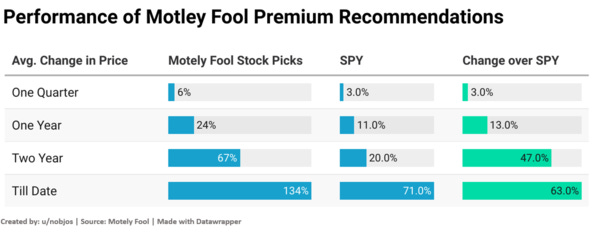

Discover more from Market Sentiment
Benchmarking all Motley Fool Premium recommendations since 2013 against S&P500!
Should you put up with their clickbaits for better returns?
Hey everyone, welcome to Market Sentiment. I track and conduct due diligence on rapidly growing stocks and do a comprehensive deep dive on one investment strategy/topic every week.
If you find this post valuable, check out some of my other posts:
To receive this newsletter in your inbox weekly, consider subscribing
There is no way around it. A vast majority of us absolutely hate The Motley Fool. I feel that it’s justified, given their clickbait titles or “5 can’t miss stocks of the century” or turning 1,000 into 100,000 posts designed just to drive traffic to their website.
Now that that’s out of the way, let’s come to my hypothesis. There are more than 1 million paying subscribers for Motley Fool’s premium subscription. This implies that they are providing some sort of value that encouraged more than 1MM customers to pay up. They have claimed on their website that they have 4X’ed the S&P500 returns over the last 19 years. I wanted to check if this claim is due to some statistical trickery or some outlier stocks which they lucked out on or was it just plain good recommendations that beat the market. Basically,
What I wanted to know was this - Would you have been able to beat the market if you had followed their recommendations?
Where is the data from: The data is from Motley Fool Premium subscription (Stock Advisor) in Canada. Due to this, the data is limited from 2013 and they have made a total of 91 recommendations for US-listed stocks. (They make one buy recommendation every 4th Wednesday of the month). I feel that 8 years is a long enough time frame to benchmark their performance. If you have seen my previous posts, I always share the data used in the analysis. But in this case, I will not be able to share the data as per the terms and conditions of their subscription.
Analysis: As per Motley Fool, their stock picks are long-term plays (at least 5 years). Hence for all their recommendations I calculated the stock price change across 4 periods and benchmarked it against S&P500 returns during the same period.
a. One-Quarter
b. One Year
c. Two Year
d. Till Date (From the day of recommendation to Today)
Another feedback that I received for my previous analysis was starting price point for analysis. In this case, Motley Fool recommends their stock picks on Wed market close, I am considering the starting point of my analysis on Thursday’s market close price (i.e, you could have bought the share anytime during the next day).
Results:
As we can see from the above chart, Motley Fool’s recommendations did beat the market over the long term across the different time periods. Their one-year returns were ~2X and two-year returns were ~3X the SPY returns. Even capping for outliers (stocks that gained more than 100%), their returns were better than the S&P benchmark.
But it’s not like all their strategies were good. As we can see from the above chart, their sell recommendations were not exactly ideal and you would have gained more if you just stayed put on your portfolio and did not sell when they recommended you to sell. One of the major contributors to this difference was that they issued a sell recommendation for Tesla in 2019 for a good profit but missed out on Tesla’s 2020 rally.
How much money should you be managing to profitably use Motley Fool recommendations?
The stock advisor subscription costs $100 per year. Considering their yearly returns beat the benchmark by 13%, to break even, you only need to invest $770 per year. Considering a 5x factor of safety as historical performance cannot be expected to be repeated and to factor in all the extra trading fees, one has to invest around $4k every year. You also have to factor in the mental stress that you will have to put up with all their upselling tactics and clickbait e-mails that they send.
Limitations of analysis: Since I am using the Canadian version of Motley Fool’s premium subscription, I have only access to the US recommendations made from 2013. But, 8 years is a considerably long time to benchmark returns for the service. Also, I am unable to share the data I used in the analysis for cross-verification by other people.
But I am definitely not the first person to independently analyze their recommendations. This peer-reviewed research publication in 2017 came to the same conclusion for the time period that was before my analysis.
We find that the Stock Advisor recommendations do statistically outperform the matched samples and S&P 500 index, since the creation of Stock Advisor in 2002 regarding both short-term and long-term holding periods. Over a longer holding period, the Stock Advisor portfolio repeatedly outperforms the S&P 500 index and matched samples in terms of monthly raw returns and risk-adjusted measures. Although the overall performance of the Stock Advisor portfolio benefits from remarkable recommendation performances between 2002 and 2006, the portfolio still exceeds the benchmarks regarding risk-adjusted measures during the subsequent period between 2007 and 2011
Conclusion:
I have some theories on why Motley Fool produces content the way they do. The free articles of the company are just created to drive the maximum amount of traffic to their website. If we have learned anything from the changes in blog headlines and YouTube thumbnails, it’s that clickbait works. I guess they must have decided that the traffic they generate from the headlines and articles far outweigh the negative PR they get due to the same articles.
Whatever the case may be, rather than hating on something regardless of the results, we could give credit where credit is due! I started the research being extremely skeptical, but my analysis, as well as peer-reviewed papers, shows that their Stock Advisor picks beat the market over the long run.
Disclaimer: I am not a financial advisor and in no way related to Motley Fools.
Subscribe to Market Sentiment
Actionable, data-backed investment insights for long-term investors, financial advisors, and analysts.





